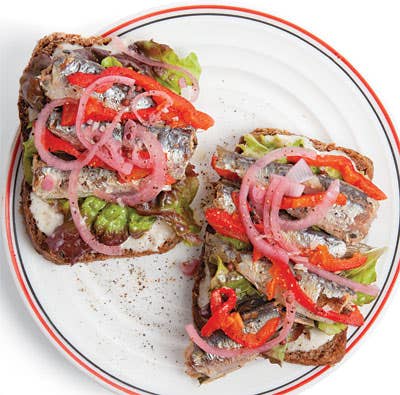
Forgotten Fish: Memories of a Sardine Sandwich
A chef recalls his favorite childhood sandwich
I fell in love with sardine sandwiches when I was 13 years old, working my first restaurant gig, at Hymie's, a beloved delicatessen in suburban Philadelphia. My favorite job was helping the in-house caterer, Murray, my first culinary mentor. He was in his sixties, an Eastern European immigrant with a heavy accent and a great work ethic. When we were done for the day, he'd make sardine sandwiches that we'd eat together, just the two of us, in the back of the kitchen. It was a simple sandwich prepared exactly as it appeared on the menu, with a can of Portuguese sardines, some good deli mustard, sliced onions, and leaf lettuce, piled onto fresh rye bread. See a recipe for a Sardine Sandwich
A generation ago, sardine sandwiches were ever present in American restaurants. Growing up, I recall their being listed on every deli, diner, sandwich shop, cafeteria, and Automat menu. Back then, the New York market consumed five million tins a year, and the sardine industry was the state of Maine's largest employer. I knew this because my father was in food sales, peddling the European gourmet specialties of that era, and we had cans of sardines around the house all the time. For an impatient teenager, it was the perfect quick meal, and as a college student, one of my favorite bargain dinners was sardines in tomato sauce packed in Fraserburgh, Scotland, also courtesy of Dad. These were tiny fish, the brisling variety; we'd eat them piled on Triscuits and wash them down with Schmidt's beer.
When huge marketing campaigns from the international tuna conglomerates began, in the 1950s, it seemed that overnight, tuna salad was in and sardines were out. Tuna was cheaper, less "fishy" tasting, and, of course, it seemed less ethnic. This ushered in the era of factory tuna trawlers, depleted tuna stocks, massive bycatch loss, and mercury as a dietary supplement. By contrast, sardines remain abundant, bycatch is very low, and their meat is loaded with vitamins, minerals, and omega-3 oils, without the heavy metals and toxins often found in larger fish.
Fresh Mediterranean sardines can be found on upscale menus all over the country, but the canned variety gets little love nowadays. So next time you visit your grocer, grab a can of European or Moroccan sardines, and make yourself a sandwich. As Murray showed me nearly 40 years ago, it's food even a kid could love. —Mike Colameco, host of Colameco's Food Show and author of Mike Colameco's Food Lover's Guide to NYC_ (Wiley, 2009)_
Keep Reading
Continue to Next Story
